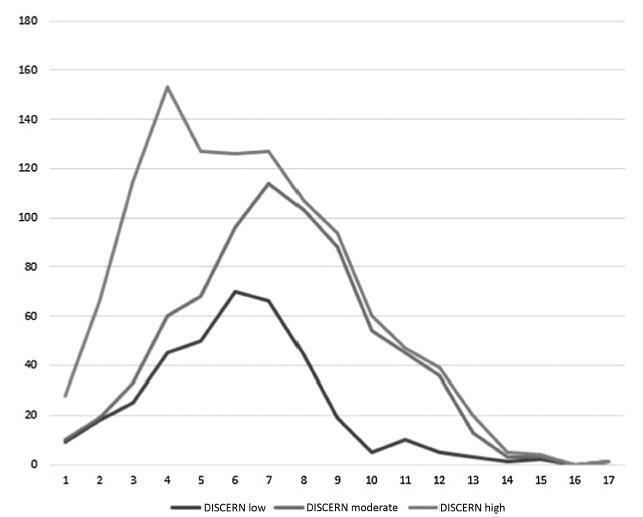-
Original Articles
Quality Information about Uterine Fibroids on the Internet
Revista Brasileira de Ginecologia e Obstetrícia. 2018;40(9):547-553
09-01-2018
Summary
Original ArticlesQuality Information about Uterine Fibroids on the Internet
Revista Brasileira de Ginecologia e Obstetrícia. 2018;40(9):547-553
09-01-2018Views118See moreAbstract
Objective
There are no published studies analyzing the quality of the information for lay women on the Internet regarding uterine fibroids. The accuracy of the provided material is also unknown. Thus, we have performed a cross-sectional study with 381 websites in the English and Brazilian Portuguese languages between May and December 2017.
Methods
Two investigators performed the analysis, and the Cohen kappa coefficient was calculated to analyze the agreement between them. Search terms (uterine fibroids and derivatives) in the English and Brazilian Portuguese languages were used. The accuracywas analyzed by a 10-itemchecklist created based on the American Society for Reproductive Medicine (ASRM), National Institutes of Health (NIH) and European Menopause and Andropause Society (EMAS) consensuses about uterine fibroids. The item-test correlation and the intraclass coefficient were performed in the 16 questions from the DISCERN instrument, which was designed to measure the quality of health information on the Internet. Analysis of variance (ANOVA) measurements were performed for the independent variables and the DISCERN/accuracy scores.
Results
Google was the most used search engine, and uterine fibroid was the search term that generatedmost of the analyzed material. The median score for accuracy in all websites was 5 out of 10, and the median score of the DISCERN instrument was 38 out of 80. The top-scoring sites in the English language were derived from scientific organizations and federal governments, and they regarded the DISCERN score (The American College of Obstetricians and Gynecologists [ACOG], the Food and Drug Administration [FDA]) and the accuracy criteria (NIH, and FDA). On the other hand, in the Brazilian Portuguese language, the highest scores in both instruments were from magazines or physician’s blogs. The Cronbach α test showed a higher correlation (0.77-0.79) between the sites and DISCERN; however, the item-test correlation varied from 0.39 to 0.56.
Conclusion
There is a need to improve the quality of the information regarding uterine fibroids for lay women.

-
Artigos Originais
Uterine fibroid embolization in women with giant fibroids
Revista Brasileira de Ginecologia e Obstetrícia. 2010;32(11):530-535
01-20-2010
Summary
Artigos OriginaisUterine fibroid embolization in women with giant fibroids
Revista Brasileira de Ginecologia e Obstetrícia. 2010;32(11):530-535
01-20-2010DOI 10.1590/S0100-72032010001100003
Views113PURPOSE: to evaluate the effectiveness of uterine fibroid embolization (UFE) in patients with giant fibroids, with regard to both clinical outcomes and size reduction. METHODS: twenty-six patients with a mean age of 36.5 years, carrying symptomatic fibroids with a volume over 1,000 cm³, were referred for UFE. All patients had indication for percutaneous treatment. The procedures were performed under epidural anesthesia and sedation, using an institutional protocol. By unilateral femoral access, selective catheterization of uterine arteries and infusion of calibrated microspheres through microcatheter were carried out. Clinical evaluation was performed by means of regular outpatient gynecology consultation. All patients underwent magnetic resonance imaging (MRI) before the procedure and 15 patients underwent control MRI after 6 months. RESULTS: technical success was 100%. There was no complication related to the procedures. Mean uterine volume of the 15 patients studied was 1,401 cm³ before embolization (min 1,045 cm³, max 2,137 cm³) and 799 cm³ after 6 months (525 cm³ min, max. 1,604 cm³), resulting in a total reduction of 42.9%. Clinical improvement was observed in 25 of 26 patients. One woman with uterine volume of 1,098 cm³ who developed necrosis and partial fibroid expulsion underwent myomectomy. Another patient was submitted to myomectomy six months after the procedure because she wanted to become pregnant, despite partial fibroid size reduction. One patient with a uterine volume of 2,201 cm³ required a second intervention to achieve an adequate angiographic result. No patient underwent hysterectomy. On average, 9.2 microsphere syringes were used per patient. CONCLUSION: embolization of giant uterine fibroids is a feasible procedure with acceptable clinical and radiological outcomes. It can be considered an option for patients who desire to preserve the uterus, and it may serve as adjuvant therapy for high-risk myomectomy.
Key-words Angiography, digital subtractionEmbolization, therapeuticHysterectomyMagnetic resonance ImagingUterine artery embolizationUterine fibroidsSee more


